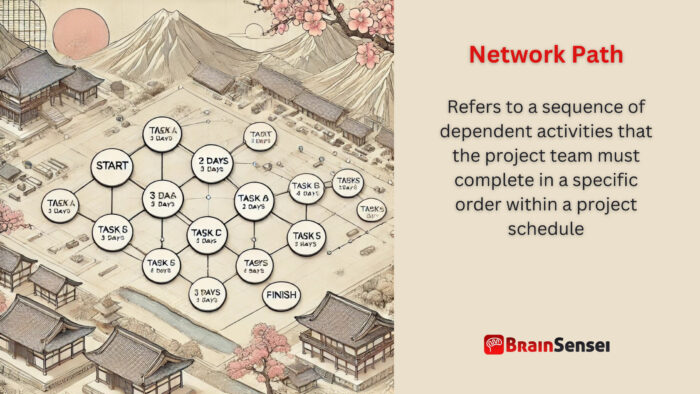
Network Path
What is a Network Path?
In project management, a network path refers to a sequence of dependent activities that the project team must complete in a specific order within a project schedule. The network path in a project’s network diagram shows the logical flow of tasks from start to finish. The longest network path determines the critical path, directly impacting the project’s duration.
Key Takeaways
- A network path is a sequence of activities with dependencies.
- The critical path is the longest network path in a project.
- Understanding network paths helps identify bottlenecks and risks.
- Proper management of network paths ensures timely project completion.
- Used in Critical Path Method (CPM) and Program Evaluation and Review Technique (PERT) scheduling.
Understanding Network Path
How It Works
Project scheduling connects tasks based on their dependencies, forming one or more network paths. Activities within each path must follow a sequence. The duration of a network path is determined by summing up the durations of its activities. The longest path determines the critical path, meaning any delay in this path will delay the entire project.
Notes
- Network paths can be parallel or sequential.
- A task’s slack (float) indicates how much delay is permissible.
- Critical path tasks possess zero floats, which prevents delays.
- Used in Gantt charts and PERT charts to visualize dependencies.
Related Terms
- Critical Path Method (CPM): This project management technique identifies the most extended sequence of dependent tasks.
- Float (Slack): The amount of time a task can be delayed without affecting the project timeline.
- Predecessor Task: The task completed before another task can start establishes a dependency between them.
- Successor Task: A task that follows a predecessor and depends on completion.
- Gantt Chart: A visual representation of a project schedule showing task dependencies and timelines.
- PERT (Program Evaluation and Review Technique): A statistical tool for analyzing project timeframes.
Examples of Network Paths in Different Industries
Construction Industry – Building a Residential Complex
In the construction industry, effective management of network paths ensures that construction projects meet timelines and budgets. Consider a residential complex project comprising several interconnected phases: site preparation, foundation laying, framing, electrical work, plumbing, roofing, interior finishing, and final inspections.
The project manager uses a network diagram to map out dependencies. For example, workers must complete foundation laying before framing and finish framing before starting electrical and plumbing work. These tasks form a path, and any delay in an early phase can have a cascading effect on subsequent tasks.
A real-world example comes from a housing development project in California. Unexpected weather delays during the foundation phase delayed the entire project. Having identified the critical path, the project manager adjusted resources to accelerate framing upon foundation completion. Additionally, some non-critical tasks, such as landscaping and exterior painting, were scheduled concurrently to compensate for lost time.
Project managers use scheduling techniques, such as the Critical Path Method (CPM) and resource levelling, to optimize network paths in construction and avoid bottlenecks.
IT & Software – Software Development Lifecycle (SDLC)
Network paths are crucial in the IT Software Development Lifecycle (SDLC). A typical software project follows this sequence of phases: requirements gathering, system design, coding, testing, deployment, and maintenance. These tasks have dependencies, and project managers must ensure the path is well-structured to prevent delays.
For example, in a mobile app development project, developers must complete the UI/UX design before coding. Similarly, developers must finish coding before they start testing and debugging. The project manager identifies the critical path to focus on tasks with zero slack and ensures timely completion.
A real-world example is an e-commerce startup launching a mobile application. The project team underestimated the time required to integrate third-party payment gateways, which caused a bottleneck in testing and deployment. The team reassessed the network path and assigned additional developers to the integration task. This form of fast-tracking helped the project meet its launch deadline despite initial setbacks.
To mitigate risks, IT project managers use tools like JIRA, Microsoft Project, and PERT charts to track dependencies and adjust schedules dynamically.
Aerospace & Defense – Aircraft Development Project
The aerospace and defence industries deal with highly complex projects that span several years. The development of an aircraft involves multiple network paths, including research, prototype design, structural testing, regulatory approvals, and final production.
For instance, the network path for developing a new commercial aircraft includes wind tunnel testing, avionics integration, structural stress analysis, and FAA certification. Any delay in structural testing can halt further progress, as safety approvals are mandatory before production can begin.
A real-world example is the Boeing 787 Dreamliner project, which experienced delays due to supplier issues in the composite materials supply chain. The project’s network path had to be reassessed to accommodate changes in supplier timelines, ultimately leading to a modified production schedule that accounted for unexpected risks.
Using PERT analysis and Monte Carlo simulations, aerospace project managers anticipate possible delays and create contingency plans to mitigate risks in the network path.
Oil & Gas Industry – Offshore Drilling Project
Network paths help coordinate large-scale projects such as offshore drilling in the oil and gas industry. The sequence of tasks includes geological surveys, site preparation, rig setup, drilling, refining, and distribution.
In a deepwater drilling project in the Gulf of Mexico, project managers developed a network path to track dependencies such as environmental impact assessments before drilling operations could begin. When regulatory approval took longer than expected, project managers used schedule compression techniques, such as crashing, to allocate additional resources for the drilling phase, ensuring that delays did not extend the project timeline.
The critical path in offshore drilling must account for unforeseen risks such as weather conditions, equipment failures, and regulatory delays. Project managers use advanced simulation tools to model these uncertainties and optimize the network path accordingly.
Manufacturing Industry – Automotive Production Line
Manufacturing projects involve multiple interdependent tasks that follow a strict network path to ensure efficiency and quality control. The assembly line in an automotive production facility consists of component manufacturing, vehicle assembly, quality control, and distribution.
For instance, a car manufacturing plant in Germany relies on a just-in-time (JIT) production system, where suppliers deliver parts precisely when needed. Any delay in engine assembly affects subsequent tasks like chassis integration and final inspections. When a global semiconductor shortage impacted production in 2021, automotive companies had to reassess their paths, prioritizing high-demand models and adjusting supply chain logistics.
By implementing network path optimization, manufacturers ensure smooth workflows and minimize production downtime, improving overall efficiency.
These real-world examples demonstrate how network paths are essential across different industries. They help project managers track dependencies, optimize schedules, and mitigate risks effectively. A well-managed network path ensures projects stay on time and within budget, regardless of industry complexities.
Use Cases of Network Paths in Different Regions
United States (Infrastructure Project)
A highway expansion project in Texas follows a network path, including environmental assessments, land acquisition, roadbed preparation, paving, and final inspections. Delays in acquiring permits impact the critical path, requiring contingency plans. The project managers use fast-tracking techniques, such as working on multiple parallel tasks, to minimize delays and keep the project on schedule.
Germany (Manufacturing)
An automobile production facility in Germany relies on a just-in-time (JIT) supply chain, where component delivery, assembly, quality testing, and distribution follow a network path. Any disruption in material supply affects the critical path, leading to production bottlenecks. Manufacturers implement dual sourcing strategies to mitigate supply chain risks and use predictive analytics to optimize the production schedule.
Saudi Arabia (Oil & Gas Exploration)
A drilling project in Saudi Arabia follows a network path from geological surveys to site preparation, drilling, and refining. Unexpected delays in site preparation can disrupt the entire path, impacting production targets. To manage risks, project teams employ real-time monitoring systems to track progress and implement contingency plans, such as reallocating resources to other critical tasks.
Understanding the network path in these diverse industries and regions can help organizations optimize project execution and ensure successful outcomes.
Best Practices for Managing Network Paths
Identify and Map Dependencies
Understanding the relationships between tasks helps prevent scheduling conflicts. Use project management tools like Microsoft Project, Primavera P6, and Smartsheet to create a network diagram outlining task dependencies.
Monitor Critical Path Regularly
Regular updates identify delays early. Critical path analysis (CPA) helps project managers focus on tasks with zero slack, ensuring they meet key milestones.
Use Schedule Compression Techniques
If delays occur, recover lost time by fast-tracking (working on parallel tasks) or crashing (adding resources to speed up tasks).
Allocate Resources Efficiently
Ensure personnel, equipment, and budget are aligned with the project’s network path to minimize disruptions.
Implement Risk Management Strategies
To minimize disruptions, perform comprehensive risk assessments for critical tasks, establish contingency protocols, and utilize Monte Carlo simulations to model and predict potential project delays.
Leverage Automation and AI
Use AI-powered scheduling tools to analyze historical data and optimize project timelines dynamically.
Regularly Review and Adjust Plans
Projects evolve, so schedules must be flexible. Regular status meetings help ensure network paths remain aligned with objectives.
Implementing these best practices can help project managers minimize risks, optimize resources, and improve efficiency in managing network paths.
Network Path: Common Mistakes and Issues
One of the most common mistakes in managing network paths is failing to identify dependencies correctly. If a project manager does not accurately map out which tasks rely on others, scheduling conflicts can arise, leading to bottlenecks.
Another significant issue is underestimating task durations, which leads to inaccurate project timelines. Underestimating task durations often cause last-minute changes, cost overruns, and missed deadlines.
Ignoring the critical path is another serious issue. Delaying a vital path task without a mitigation strategy impacts the entire project timeline.
Additionally, poor communication between teams can lead to misalignment in task execution. Siloed departments overlook dependencies, causing significant scheduling disruptions.
Project managers sometimes also fail to monitor float/slack properly, leading to inefficient resource allocation. Understanding task flexibility helps balance workload distribution because not all tasks require immediate completion.
A real-world example is a large-scale IT project initiated coding before finalizing requirements. This mistake led to extensive rework, increasing costs and extending the project timeline. Had the network path been adequately analyzed, coding would have been scheduled after thorough requirement gathering, avoiding inefficiencies.
By recognizing these common pitfalls and implementing proactive strategies, organizations can ensure that their network paths are well-structured, improving project success rates and minimizing risks.
Network Path: Frequently Asked Questions (FAQs)
What is the difference between a network path and a critical path?
A network path is any sequence of dependent activities in a project. The critical path is the longest network path, determining the project’s minimum duration.
Why is network path analysis critical?
It helps identify task dependencies, optimize scheduling, allocate resources efficiently, and mitigate risks that could delay the project.
Can a project have multiple critical paths?
Yes, a project can have multiple critical paths, which increases the project’s risk level.
How do project managers handle delays in the network path?
They use schedule compression techniques to recover lost time, such as fast-tracking (overlapping tasks) and crashing (adding resources).
Which tools analyze network paths?
Standard tools include Microsoft Project, Primavera P6, Smartsheet, and Gantt charts, which help visualize and manage network paths.
Additional Resources
- Calculating Critical Path
- What Is the Critical Path in Project Management?
- The critical path method in project management: Your guide
Preparing for a PMI certification?
- Exam Prep Courses: PMP®, CAPM®, and PMI-ACP®
- Exam Simulators: PMP®, CAPM®, PMI-ACP®, PMI-PBA®, PMI-RMP®, PMI-SP®, PgMP®, and PfMP®
- Professional Development Units (PDUs): 15, 30, and 60 PDU Bundles



